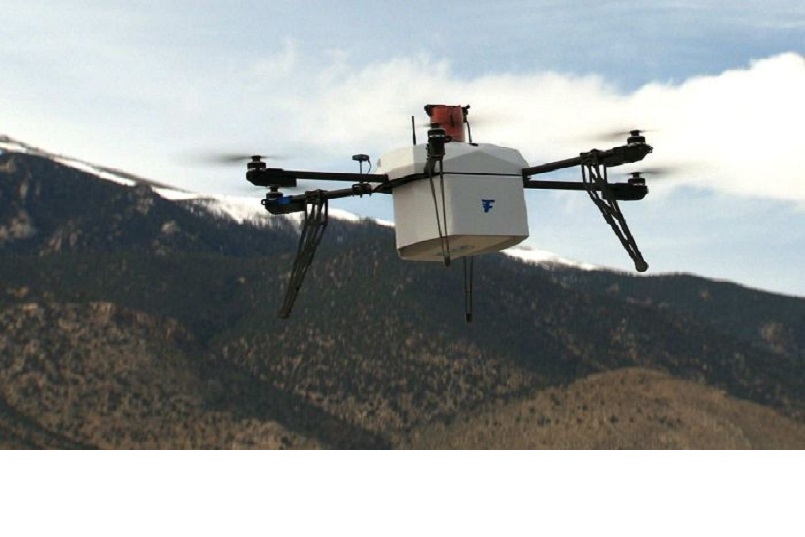
A pizza or a pair of shoes, a first aid kit or crucial medicines — a small airborne robot can deliver it to your door.
It may sound far-fetched but it is closer to reality than you think. And a tiny Australian company called Flirtey claims to be at the front of the flying drone pack.
Flirtey has already made a commercial drone delivery, albeit under strictly controlled conditions.
"I see a not too distant future where seeing a drone delivering a package to you or your neighbour is more common than seeing a postman or Fedex van deliver packages today," Flirtey chief executive officer Matt Sweeny said.
The company is working with the US national space agency NASA to help develop an air traffic control system for drones — also known as UAVs, or unmanned aerial vehicles — to keep them away from other aircraft.
Flirtey is run by 27-year-old Mr Sweeny and his partner Tom Bass, who have made it their mission to make door-to-door drone delivery a reality. Last year, they succeeded in making the first commercial drone delivery ever allowed in the US — though still done within line of sight — when they delivered medical supplies to a rural clinic in Virginia.
Then in March they claimed another first: conducting a Federal Aviation Administration (FAA)-approved urban delivery at the Hawthorne military base in Nevada.
Mr Sweeny, the Australian company's chief executive, said it was more than holding its own against the giants.
"I think that Amazon and Google are competing with us," Mr Sweeny said.
"When I look at the history of technology, it's very rarely the incumbent who wins when there is disruption.
"We're the visionaries who saw the industry, and we've got a track record of achievement beating both Amazon and Google in a foot race to get the first FAA approval on their own soil."
The delivery technology is already available. The main hold-up is safety.
Technology companies globally are racing each other to develop foolproof sense-and-avoid software, virtual fencing, longer life batteries, hybrid vehicles, battery charging stations and emergency landing systems to convince safety regulators that commercial drones should be allowed to operate in urban environments.
But to deliver things like pizza and small consumer items door-to-door, the drone makers need to convince the FAA that their vehicles can safely fly beyond the operator's line of sight, even in busy urban settings.
Pilots warn US aviation watchdog of dire consequences
Airline pilots and other aviation groups have expressed concern, with Captain Tim Canoll, president of the Airline Pilots Association, saying it is a matter of when, not if something goes wrong.
"They do have batteries in them and these are dense heavy metal pieces that will wreak havoc on an aircraft when it hits a transport category aircraft," Mr Cannoll told a recent congressional hearing.
FAA deputy administrator Mike Whitaker agrees drones do pose risks to passenger aircraft.
"It's possible in the sense that we've seen birds bring down planes," Mr Whitaker said.
"It's highly unusual, but it certainly is possible.
"But our focus is again on just keeping the separation so we don't test the premise."
Software enabling drones to talk directly to NASA's systems
The NASA system Flirtey and others are trialling uses computer software and mobile technology to quarantine air routes for drones well below commercial aircraft at heights of between 60 and 120 metres.
One NASA partner is the Nevada Advanced Autonomous Systems Innovation Centre (NAASIC) in Reno.
NAASIC business director Warren Rapp said UAVs were talking to each other and sharing data.
"The UAVs are also sending [data] to a centralised control source or a management source and so at any given time, you'll have a complete situation awareness on what those UAV's are doing," Mr Rapp said.
"There are flight plans that are in the system where they're supposed to be going and in addition to that, those UAVs will be equipped with certain types of software that allow them to see things that maybe nobody else can see.
"It could even be large birds or flocks of birds or other things and they will be able to actually avoid that per their programming."
Privacy issues need to resolved before pizzas fly
The FAA will allow broader commercial operations as soon as June this year. The safest operations will come first, in rural or unpopulated areas where drones pose few risks.
But do not plan on ordering that pizza by drone just yet.
"It may be a while," Mr Whitaker said.
"As we talk about stakeholder engagement I think part of that engagement includes your neighbour who may not want a vehicle coming over her property to deliver your pizza.
"So there will be broader interests, privacy interests, neighbourhood interests and noise interests that have to really be part of that equation.
"Not everybody may embrace that concept of having the smallest item delivered on demand."
Drones 'going to be something people don't even think about'
But according to University of Nevada robotics expert Dr Richard Kelley, whose software enables Flirtey's drones to talk to NASA's computers, it is happening.
"I think that with unmanned aircraft it's going to get boring in a good way," Dr Kelley said.
"I think that in a generation or two that's going to be something people don't even think about."
